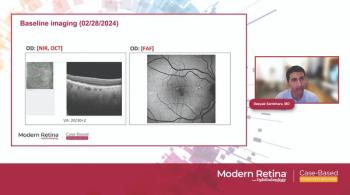
Nitrosative & oxidative stress is associated with structural changes
In this article, the authors present their recent study results. The study findings demonstrated, for the first time, that in vivo structural changes in ISel band and RPE are associated with increased plasma nitrosative and oxidative stress.
Take-home message: In this article, the authors present their recent study results. The study findings demonstrated, for the first time, that in vivo structural changes in ISel band and RPE are associated with increased plasma nitrosative and oxidative stress.
By Prof. Sandeep Saxena MS, FRCSEd, FRCS, FRCOphth and Dr Khushboo Srivastav MS
Research on the pathophysiology of diabetic retinopathy has typically been focused on dysfunction of the neuroretina and the breakdown of the inner blood retinal barrier. By contrast, the effect of diabetes mellitus on the
In our recently published study, we examined the levels of plasma nitric oxide (NO) and lipid peroxide (LPO) in diabetic retinopathy and its association with the severity of disease, disruption of photoreceptor ISel band and topographic alterations in RPE for the first time.
Study details
As published in Clinical and Experimental Ophthalmology,2 60 consecutive cases of type 2 diabetes mellitus and 20 healthy controls were included in a tertiary care centre-based prospective, cross-sectional study. Cases were divided into three groups on the basis of ETDRS classification: patients of diabetes mellitus without retinopathy (NODR) (n = 20), non-proliferative diabetic retinopathy (NPDR) with diabetic macular oedema (n= 20), and proliferative diabetic retinopathy (PDR) with diabetic macular oedema (n = 20). Cases with age-related macular degeneration were excluded.
Photoreceptor ISel integrity, on horizontal and vertical scans through the fovea, and RPE topography, on three dimensional imaging, was evaluated using Cirrus High Definition SD-OCT (Carl Zeiss Meditec Inc., CA, United States). Every study subject underwent analysis using macular cube 512x128 feature. Using two experienced observers, disruption of the photoreceptor ISel was studied (Figure 1 and Table 1). Data on topographic alterations in RPE was evaluated via a single layer retinal pigment epithelial map (Figure 2 and Table 2).
The parameters for measuring nitrosative and oxidative stress were NO, LPO and reduced glutathione (GSH) levels in plasma using the standard protocol.
Analysis findings
Analysis revealed that increased levels of plasma NO, LPO and decreased levels of plasma GSH was associated with increased severity of diabetic retinopathy. Plasma Levels of NO, LPO, and GSH differed significantly among the study groups.
Increased severity of diabetic retinopathy was found to be associated with an increase in oxidative and nitrosative stress markers [LPO (r = 0.05 p < 0.05), GSH (r = -0.39 p < 0.0001), NO (r = 0.38, p < 0.001)], an increase in disruption of the photoreceptor ISel (r = 0.5, p < 0.001) as well as topographic alterations in RPE (r = 0.3, p < 0.01).
Decrease in visual acuity was found to be associated with increased disruption of the photoreceptor ISel (r = 0.67, p < 0.001) and topographic alterations in RPE (r = 0.72, p < 0.001). The nitrosative stress marker was also found to be significantly associated with severity of photoreceptor ISel disruption (r = 0.49, p <0.001). and topographic alterations in RPE (r = 0.58, p <0.001). Similarly, significant correlation was found between oxidative stress markers, severity of photoreceptor ISel disruption (r = 0.09, p < 0.05) and topographic alterations in RPE (r = 0.11, p < 0.05).
Several animal models of retinal diseases have previously implicated nitrosative stress to photoreceptor damage and breakdown of blood retinal barrier.3,4 NO has been demonstrated to decrease rod outer segment phagocytosis by RPE cells.5 Human RPE cell proliferation has also been shown to be inhibited by exogenous NO. 6 RPE has been found to be responsible for metabolism of the photoreceptor layer.7
Our recent study results demonstrate the positive correlation of N- Carboxy Methyl Lysine (N-CML), vascular endothelial growth factor (VEGF) and intercellular adhesion molecule-1 (ICAM-1) with photoreceptor structural integrity and visual acuity in diabetic retinopathy, thus providing further insight into the pathogenesis of the disease.8,9
Activation of the PI3K/mTOR/ translational pathway has been reported to be important for IFNgamma-mediated VEGF expression in RPE cells.10
In conclusion, increased plasma nitrosative stress is associated with increased severity of diabetic retinopathy. For the first time in our study, it was demonstrated that in vivo structural changes in ISel band and RPE are indeed associated with increased plasma nitrosative and oxidative stress.
References
- R. Simó R et al., Current Diabetes Reviews. 2006;2:71–98.
- S. Sharma et al., Clin. Exp. Ophthalmol. 2015. doi: 10.1111/ceo.12506. [Epub ahead of print]
- J. Liversidge, A. Dick and S. Gordon. Am. J. Pathol. 2002;160:905–916.
- G-S. Wu, J. Zhang and N.A. Rao. Invest. Ophthalmol. Vis. Sci. 1997; 38:1333–1339.
- F. Becquet, Y. Courtois and O. Goureau. Cell Physiol. 1994;159:256-262.
- G. Yilmaz et al., Eye. 2000;14:899-902.
- S. Hamann et al., Am. J. Physiol. 1998;274:1332-1345
- S. Saxena et al., JSM Biotechnol. Bioeng. 2014;2:1039.
- A. Jain et al., Mol. Vis. 2013;19:1760-1808.
- B. Liu, L. Faia, M. Hu and R. Nussenblatt. Molecular Vision. 2010;16:184– 193.
Prof. Sandeep Saxena, MS, FRSCEd, FRCS, FRCOphth
e: sandeepsaxena2020@yahoo.com
Prof. Sandeep Saxena is the Chief of Retina Service, Department of Ophthalmology, King George’s Medical University, Lucknow, India.
Dr Khushboo Srivastav, MS
e: justbkhush19@gmail.com
Dr Khushboo Srivastav is Resident at the Retina Service, Department of Ophthalmology, King George’s Medical University, Lucknow, India.
The authors have no financial disclosures relating to the content of this article.
Newsletter
Keep your retina practice on the forefront—subscribe for expert analysis and emerging trends in retinal disease management.







































